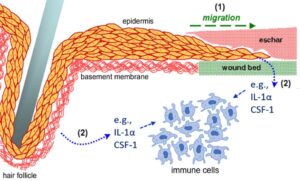Education
- Albany Medical College2015PhD
- Siena College2007BS
Research
My scientific career has been dedicated to studying skin biology with a focus on epidermal integrins. As the major cell adhesion receptors for extracellular matrix, integrins mediate bidirectional signaling that regulates the cell’s ability to sense changes in the tissue microenvironment, and to respond to those changes. During my graduate studies, I investigated roles for integrins in cutaneous wound healing and blistering skin diseases, as well as the combinatorial roles of distinct epidermal integrins in these contexts. During my time as a postdoctoral fellow, I studied roles for integrin α3β1 in epidermal tumor growth and in regulation of a secretome that supports the skin tumor microenvironment. Consistent with the idea that “tumors are like wounds that do not heal” (Dvorak, 1986), functions of α3β1 that are well-regulated in wound healing are dysregulated in tumorigenesis. In cooperation with the DiPersio Lab, a long-term goal is to target α3β1 with therapeutic strategies to inhibit cancer growth and progression, expedite the wound healing process, or treat pathological wounds.
Wound Healing Therapies for the Elderly
The development of effective wound healing therapies for the elderly requires a greater understanding of the complex interactions between the epidermis and the wound microenvironment, and how these interactions change with age. Epidermal integrin α3β1 is an excellent candidate to study in this regard, as it is a targetable cell receptor with critical roles in wound healing that are likely to diminish with age. What makes this integrin particularly exciting is that it mediates both “autocrine” keratinocyte functions, such as the process of epidermal re-epithelialization, for example, as well was “paracrine” functions (i.e., crosstalk to distinct cell types) in wound healing. While “classical” cell-autonomous roles for individual epidermal integrins during wound healing have been studied, our understanding of how keratinocyte integrins coordinate paracrine functions during wound healing are just beginning to be uncovered. We use in vitro and in vivo methods to understand roles of epidermal integrin α3β1 in wound healing, and how they may change in aging skin. Currently, we are focused on understanding the role of epidermal α3β1 in wound re-epithelialization, as well as in paracrine crosstalk to immune cells during cutaneous wound healing. Both of these processes are critical to the wound healing process and are impaired in the elderly.

Pictured: α3β1-dependent functions in epidermis that contribute to wound healing in vivo.
(1) epidermal migration over ECM during re-epithelialization.
(2) production of factors that stimulate immune cells, such as IL-1α and CSF-1.
Publications
View Whitney Longmate's articles on the National Institute of Health's PubMed website.
Manuscripts
Dhulipalla, S., Albeche Duarte, G., Wu, L., DiPersio, M., Lamar, J., DiPersio, C.M. and Longmate, W. (2024) Keratinocyte Integrin α3β1 Promotes Efficient Healing of Wound Epidermis. JID Innovations 5(1):100310. [PMID: 39385750]
**Selected by AMC Faculty Senate as Article of the Month
Longmate, W., Norton, E., Albeche Duarte, G., Wu, L., DiPersio, M., Lamar, J., and DiPersio, C.M. (2024) Keratinocyte integrin α3β1 induces expression of the macrophage stimulating factor, CSF-1, through a YAP/TEAD-dependent mechanism. Matrix Biology 127:48-56. [PMID:38340968]
Varney, S., Wu, L., Longmate, W., DiPersio, C.M., and VanDeWater, L. (2022) Loss of integrin α9β1 on tumor keratinocytes enhances the stromal vasculature and growth of cutaneous tumors. J Invest Dermatol 142(7):1966-75.
Longmate, W., Miskin, R.P., VanDeWater, L., and DiPersio, C.M. (2021) Epidermal integrin α3β1 regulates tumor-derived proteases BMP-1, MMP-9 and MMP-3. JID Innovations 1(2):100017.
*Equal first authors.
Longmate, W., Varney, S., Power, D., Miskin, R.P., Anderson, K., DeFreest, L., VanDeWater, L., and DiPersio, C.M. (2021) Integrin α3β1 on tumor keratinocytes is essential to maintain tumor growth and promotes a tumor-supportive keratinocyte secretome. J Invest Dermatol 141(1):142-151.
**Selected for journal cover photo
Zheng, R., Longmate, W., DeFreest, L., Varney, S., Wu, L., DiPersio, C.M., and VanDeWater, L. (2019) Keratinocyte integrin α3β1 promotes secretion of IL-1α to effect paracrine regulation of fibroblast gene expression and differentiation. J Invest Dermatol 139(9):2029-38.
Longmate, W., Lyons, S., DeFreest, L., VanDeWater, L., and DiPersio, C.M. (2018) Opposing roles of epidermal integrins α3β1 and α9β1 in regulation of mTLD/BMP-1-mediated laminin-γ2 processing during wound healing. J Invest Dermatol 138(2): 444-51.
Reviews and Book Chapters
Longmate, W. (2024) The epidermal integrin-mediated secretome regulates the skin microenvironment during tumorigenesis and repair. Matrix Biology 34:175-183. [PMID: 39491760]
Dhulipalla, S., Longmate, W. (2024) Integrin mutations in blistering skin diseases and related genetically engineered mouse models. Human Immunology 85(6):111175. [PMID: 39532028]
DiPersio, C.M and Longmate, W. (2023) Integrin α3β1: Roles beyond adhesion in development and disease. Integrins in Health and Disease: Key Effectors of Cell-Matrix and Cell-Cell Interactions. Springer, Biology of Extracellular Matrix (13):27-95.
Longmate, W. (2020) Keeping a Secretome: Emerging roles for epithelial integrins in controlling a stroma-supportive secretome. J Dermatol & Skin Sci 2(2):13-20.
Longmate, W. and DiPersio, C.M. (2017) Beyond adhesion: emerging roles for integrins in control of the tumor microenvironment [version 1; referees: 4 approved]. F1000Research 2017, 6(F1000 Faculty Rev):1612 (doi: 10.12688/f1000research.11877.1)
Longmate, W. and DiPersio, C.M. (2014) Integrin regulation of epidermal functions in wounds. Adv Wound Care 3(3):229-46.